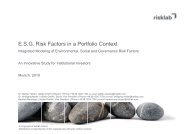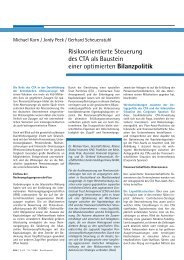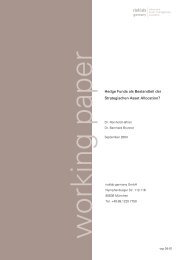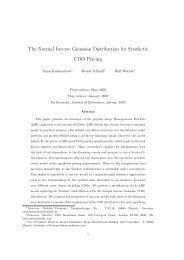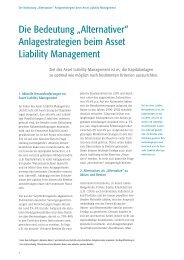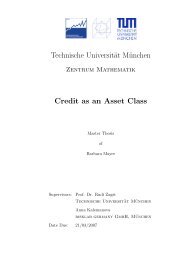Technical University Munich Commodities as an Asset Class - risklab
Technical University Munich Commodities as an Asset Class - risklab
Technical University Munich Commodities as an Asset Class - risklab
You also want an ePaper? Increase the reach of your titles
YUMPU automatically turns print PDFs into web optimized ePapers that Google loves.
2.1 The different Commodity Types<br />
Closing this section in 2.1.3.3, we will introduce live <strong>an</strong>d feeder cattle <strong>as</strong> the major<br />
exch<strong>an</strong>ge traded representatives of livestock, the l<strong>as</strong>t big sub group of the agricultural<br />
commodities. We will see that the major influencing factors of a potential<br />
investment in this commodity group are price stability in grains markets <strong>an</strong>d <strong>an</strong>imal<br />
epidemics. First, livestock prices are influenced by their production costs including<br />
costs for corn, wheat <strong>an</strong>d soybe<strong>an</strong>s. Therefore, this group of agricultural commodities<br />
is indirectly driven by weather conditions having direct impact on the input<br />
product feed. Second, the major direct risk factor in livestock markets are epidemics<br />
that require to destroy huge herd amounts. Nevertheless, trading le<strong>an</strong> hogs<br />
is getting more popular <strong>as</strong> well <strong>an</strong>d new products enable investors to ”feed” hogs<br />
”on paper”. This is described in Appendix B.12.<br />
2.1.3.1 Softs exemplified by Cocoa<br />
500 years ago, Sp<strong>an</strong>ish discoverer found a pl<strong>an</strong>t in South America <strong>an</strong>d called it<br />
cocoa ”the food of the gods”. Today, it remains a valued commodity used to produce<br />
chocolate <strong>an</strong>d cocoa powder for direct sale or bakery articles <strong>an</strong>d cocoa butter mainly<br />
used for bakery articles, soap <strong>an</strong>d cosmetics. The scope of application is not driven<br />
by possible sudden dem<strong>an</strong>d shocks. The sensitive factor is production that might<br />
be interrupted by bad weather conditions. Figure 2.10 shows the historical cocoa<br />
price development since 1960.<br />
Figure 2.10: Cocoa Be<strong>an</strong> Price<br />
The huge price incre<strong>as</strong>e in the 1970s w<strong>as</strong> caused by the US hyper inflation inducing<br />
a general commodity price incre<strong>as</strong>e. In 2006, cocoa costs on average 71 cents per<br />
pound that is around 5 cents above its average price since 1960 of 65 cents. Two<br />
thirds of world production comes from Africa whereby Cote d’Ivories with 39% of<br />
23



